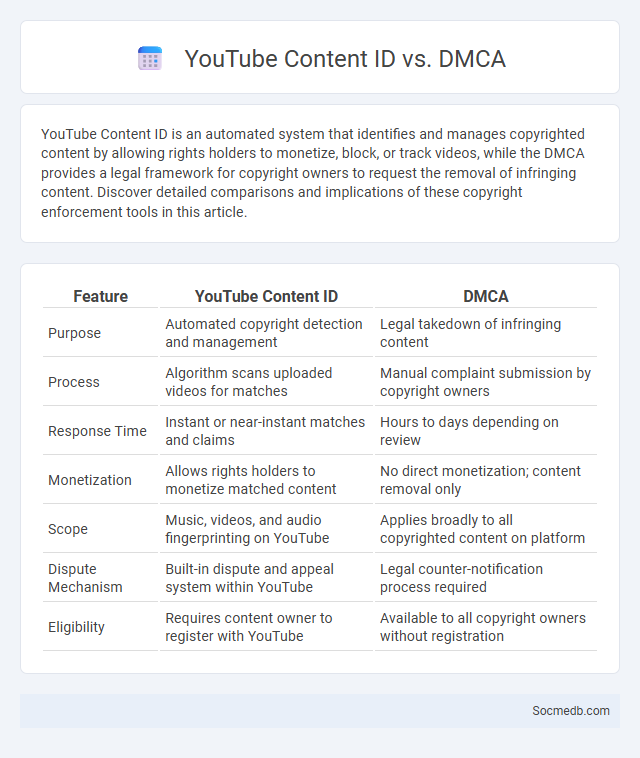
Photo illustration: YouTube Content ID vs DMCA
YouTube Content ID is an automated system that identifies and manages copyrighted content by allowing rights holders to monetize, block, or track videos, while the DMCA provides a legal framework for copyright owners to request the removal of infringing content. Discover detailed comparisons and implications of these copyright enforcement tools in this article.
Table of Comparison
| Feature | YouTube Content ID | DMCA |
|---|---|---|
| Purpose | Automated copyright detection and management | Legal takedown of infringing content |
| Process | Algorithm scans uploaded videos for matches | Manual complaint submission by copyright owners |
| Response Time | Instant or near-instant matches and claims | Hours to days depending on review |
| Monetization | Allows rights holders to monetize matched content | No direct monetization; content removal only |
| Scope | Music, videos, and audio fingerprinting on YouTube | Applies broadly to all copyrighted content on platform |
| Dispute Mechanism | Built-in dispute and appeal system within YouTube | Legal counter-notification process required |
| Eligibility | Requires content owner to register with YouTube | Available to all copyright owners without registration |
Understanding YouTube Content ID
YouTube Content ID is a powerful digital rights management system that allows copyright holders to identify and manage their content on the platform by scanning uploaded videos for matches with a comprehensive database of copyrighted material. This system enables creators and rights owners to monetize, track, or block unauthorized uses of their videos, music, or other media, ensuring better control over content distribution and revenue generation. Understanding Content ID policies and claims is essential for creators to avoid strikes, resolve disputes efficiently, and maintain a positive presence on YouTube.
What Is DMCA and How Does It Work?
The Digital Millennium Copyright Act (DMCA) is a U.S. law designed to protect copyrighted content on social media platforms by allowing copyright owners to request the removal of infringing material. When you submit a DMCA takedown notice to a platform, the content is usually removed or disabled promptly to avoid legal liability. Understanding DMCA helps you safeguard your original work and navigate copyright disputes effectively on social media.
Content ID vs DMCA: Key Differences
Content ID and DMCA serve different roles in digital content protection on social media platforms. Content ID is an automated system used by platforms like YouTube to identify and manage copyrighted content, enabling rights holders to monetize, track, or block unauthorized use. Your choice between using Content ID and filing a DMCA takedown notice should depend on whether you prefer automated content management or a manual legal takedown process.
How YouTube Content ID Detects Copyrighted Material
YouTube Content ID uses advanced fingerprinting technology to scan uploaded videos for copyrighted audio and visual content by comparing them against a vast database of copyrighted material submitted by content owners. The system identifies matches through digital signatures that represent unique aspects of the copyrighted work, enabling automated claims, monetization, or blocking of unauthorized use. This process ensures content creators and copyright holders maintain control over their intellectual property while streamlining rights enforcement on the platform.
The DMCA Takedown Process Explained
The DMCA takedown process protects your content on social media by allowing you to request the removal of unauthorized or infringing material quickly. When you submit a valid DMCA takedown notice, the platform must act promptly to take down the content to avoid liability. Understanding the specific requirements and maintaining proper documentation ensures your request is effective and legally compliant.
Benefits and Limitations of Content ID
Content ID on social media platforms enables creators to protect their original videos by automatically detecting and managing copyrighted material, ensuring proper monetization and reducing unauthorized use. Your ability to leverage Content ID benefits includes increased revenue streams and enhanced control over content distribution, but limitations arise from occasional false claims and disputes that can impact content visibility. Understanding these factors helps you balance protection with fair use rights, optimizing your content's reach and security.
Legal Implications: Content ID vs DMCA
Content ID and the Digital Millennium Copyright Act (DMCA) serve distinct legal functions in managing copyright on social media platforms. Content ID is an automated system used by YouTube to detect and manage copyrighted material, allowing rights holders to monetize, block, or track unauthorized uploads. Your understanding of these tools is crucial for navigating copyright enforcement and avoiding legal disputes in online content sharing.
How Creators Can Protect Their Work on YouTube
Creators can protect their work on YouTube by enabling Content ID, which automatically scans videos for unauthorized use and helps claim or monetize infringing content. Utilizing YouTube's copyright strike system allows creators to report violations and request removal of copied material, safeguarding original content. You should also consider watermarking your videos to deter theft and prove ownership.
Dispute Resolution: Content ID Claims vs DMCA Notices
Dispute resolution on social media platforms often involves navigating Content ID claims and DMCA notices, both crucial for protecting copyrighted material. Content ID automatically detects copyrighted content, allowing rights holders to monetize or block videos, while DMCA notices require manual submission to formally request content removal. Efficient management of these tools helps balance creators' rights and platform compliance with copyright laws.
Choosing the Best Copyright Protection for Your Content
Selecting the best copyright protection for your social media content involves understanding Digital Millennium Copyright Act (DMCA) takedown notices to swiftly remove unauthorized use. Utilizing content identification tools like Facebook Rights Manager and YouTube Content ID helps to monitor and enforce your intellectual property automatically. Registering your work with the U.S. Copyright Office strengthens legal standing and enables statutory damages in cases of infringement on social platforms.
 socmedb.com
socmedb.com